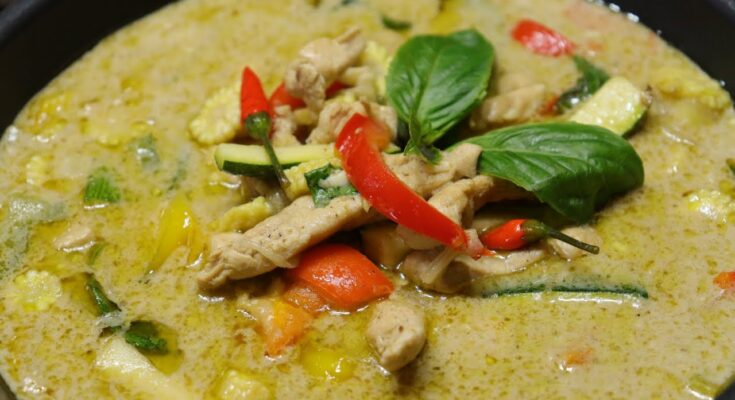Green Thai Curry Recipe: Craving something aromatic, creamy, spicy, and packed with flavor? Look no further than a hearty bowl of Green Thai Curry. It’s the perfect blend of heat, sweetness, and creaminess – a true culinary hug from Thailand. Whether you’re a beginner cook or a seasoned pro in the kitchen, this easy step-by-step guide will help you whip up an authentic green curry that’ll rival your favorite Thai restaurant.
Let’s take your taste buds on a trip to Thailand, shall we?
Why You’ll Love This Green Thai Curry
If you’ve never made Thai curry at home, you might be wondering why it’s worth the effort. But the truth is – this dish isn’t just delicious, it’s also super customizable, quick to prepare, and makes your whole house smell like heaven.
- Bursting with flavor: From the fresh herbs in the green curry paste to the richness of coconut milk, every spoonful is an explosion of taste.
- One-pot wonder: Minimal cleanup, maximum flavor.
- Customizable: Use chicken, shrimp, tofu, or any vegetables you like.
- Meal prep friendly: It stores and reheats like a dream.
- Naturally gluten-free and dairy-free: Perfect for dietary restrictions.
Sound tempting? Keep reading.
What is Green Thai Curry?
Green Thai Curry, or Gaeng Keow Wan in Thai, is one of the most popular dishes in Thai cuisine. It’s known for its vibrant green color, rich coconut milk base, and a perfect balance of sweet, salty, sour, and spicy flavors.
At its heart, the curry is a medley of fresh ingredients – Thai green chilies, lemongrass, garlic, kaffir lime leaves, and basil – blended into a fragrant paste. This is cooked with coconut milk and simmered with your choice of protein and vegetables.
It’s not just food; it’s an experience. And once you master it, you’ll wonder why you ever ordered takeout.
Origin of Thai Green Curry
The roots of Thai green curry trace back to Central Thailand, evolving over centuries through regional influences. While it’s now a staple in Thai restaurants worldwide, traditional green curry is deeply connected to the cultural essence of Thai cooking — fresh herbs, balance of flavors, and the use of coconut in everyday dishes.
The dish became widely popular during the mid-20th century when Thai cuisine began gaining global recognition. Thanks to its bold flavor and adaptable nature, green curry is now one of the most celebrated Thai dishes internationally.
List of Ingredients You’ll Need
Main Ingredients for Curry
- 2 tbsp vegetable oil or coconut oil
- 3–4 tbsp green curry paste (store-bought or homemade)
- 400ml (14 oz) full-fat coconut milk
- 500g (1 lb) chicken breast, thinly sliced (or tofu/shrimp)
- 1 red bell pepper, sliced
- 1 zucchini, sliced
- 1 cup snap peas or green beans
- 1 tbsp fish sauce (or soy sauce for vegan version)
- 1 tsp palm sugar or brown sugar
- 1–2 kaffir lime leaves (optional but authentic)
- A handful of Thai basil leaves
- Juice of 1 lime
For Homemade Green Curry Paste (Optional but Authentic)
- 6–10 Thai green chilies (adjust to taste)
- 1 shallot, chopped
- 3 cloves garlic
- 1 lemongrass stalk, chopped
- 1-inch piece of galangal or ginger
- Zest of 1 lime
- 1 tsp coriander seeds
- 1 tsp cumin seeds
- 1/2 tsp white pepper
- 1 tbsp shrimp paste (optional)
- A handful of fresh cilantro (with stems)
- A few Thai basil leaves
Blend all ingredients in a food processor until smooth.
Substitutions and Variations
- Use tofu or tempeh for a vegan/vegetarian version.
- Swap bell pepper with mushrooms, baby corn, or eggplant.
- Use light coconut milk for a lower-calorie option (but full-fat is best for creaminess).
- Instead of chicken, try beef, pork, shrimp, or a mix of seafood.
Tools and Kitchen Equipment Required
- Large non-stick skillet or wok
- Cutting board and sharp knife
- Measuring spoons and cups
- Blender or food processor (if making curry paste)
- Wooden spoon or spatula
- Saucepan (if serving with rice)
Having everything prepped and within reach will make the cooking process smooth and enjoyable.
Step-by-Step Guide to Making Green Thai Curry
Step 1: Prepare the Green Curry Paste
Use homemade or store-bought green curry paste. If making it fresh, blend green chilies, lemongrass, garlic, galangal, shallots, kaffir lime zest, cilantro stems, and spices into a smooth paste.
Step 2: Sauté Aromatics and Curry Paste
Heat a little oil in a pot. Add a few tablespoons of curry paste and sauté for 1–2 minutes until fragrant. This step helps release the oils and intensifies the flavor.
Step 3: Add Coconut Milk
Slowly stir in coconut milk, mixing well to create a creamy base. Bring to a gentle simmer to allow the flavors to blend.
Step 4: Add Protein and Vegetables
Add your protein—chicken, tofu, shrimp, or beef—along with vegetables like eggplant, bell peppers, or bamboo shoots. Simmer until the protein is cooked and the vegetables are tender.
Step 5: Season and Simmer
Add fish sauce, sugar, and lime leaves. Simmer for another 5–10 minutes to enhance the depth and balance of flavors.
Step 6: Garnish and Serve
Finish with Thai basil, cilantro, and a squeeze of lime. Serve hot over jasmine rice. Enjoy!
Tips for Making Authentic Thai Green Curry
Here are some key tricks and tips to get your curry tasting like it came straight from a Bangkok street vendor:
- Use fresh herbs: Thai basil, lemongrass, and kaffir lime leaves make a huge difference.
- Don’t rush the paste: Sauté it well before adding coconut milk to develop flavor.
- Coconut milk quality matters: Go for full-fat and avoid ones with additives.
- Balance the taste: Adjust with sugar, lime, and fish sauce as needed.
- Cook veggies briefly: Keep them vibrant and slightly crisp, not mushy.
Making green curry is less about precision and more about intuition. Taste, tweak, and trust the process.
Choosing the Right Coconut Milk
Not all coconut milk is created equal. For a rich, velvety curry, here’s what to look for:
- Full-fat coconut milk (around 17–22% fat) gives the curry its luscious texture.
- Avoid low-fat or “lite” versions – they’re watery and lack flavor.
- Check the ingredients: The best brands have just coconut and water. No gums or preservatives.
- Shake the can before opening – the cream often separates and sits on top.
Brands like Aroy-D, Chaokoh, or Thai Kitchen are highly recommended for cooking Thai dishes.
If you only have coconut cream, you can dilute it slightly with water. If you’re using a carton of coconut milk, make sure it’s for cooking and not for drinking – they’re not the same!
How to Adjust Spice Level
Green curry is known for its heat – but you can totally control how spicy it gets.
Here’s how:
- Mild: Use 1–2 tbsp curry paste, and choose a brand with a mild profile.
- Medium: 3–4 tbsp paste, or more if using homemade.
- Hot: Add extra Thai green chilies or crushed chili flakes during cooking.
You can also stir in a little sugar or extra coconut milk to mellow out a curry that turns out hotter than expected.
And remember: it’s easier to add heat than to take it away!
Protein Options: Chicken, Tofu, Shrimp, or Beef
One of the best things about Thai green curry? It’s endlessly adaptable when it comes to protein. Whether you’re a meat lover or plant-based, there’s a variation that suits your taste perfectly.
Chicken
This is the most traditional and widely used option. Boneless, skinless chicken breast or thighs work great. Thighs add more flavor and stay juicy, while breasts cook faster and are leaner. Slice them thin so they cook evenly and soak up the curry sauce.
Tofu (Vegan Option)
Tofu is a great plant-based protein for curry. Use extra-firm tofu, and press it first to remove excess water. For best results, pan-fry or bake the tofu cubes before adding them to the curry – this gives them a lovely golden texture and helps them hold their shape.
Shrimp or Prawns
Seafood gives a naturally sweet contrast to the spice of the curry. Use cleaned, tail-on shrimp and add them towards the end of cooking, as they only take 2–3 minutes to cook. Overcooked shrimp turn rubbery, so watch them closely!
Beef or Pork
Thinly sliced beef (like sirloin or flank steak) works beautifully, especially if you give it a quick sear before adding it to the curry. Pork tenderloin is another option, but it needs a gentle simmer to stay tender.
Want to mix it up? Try a combo of proteins – chicken and shrimp is a popular pairing.
Vegetables That Work Best
Green Thai curry isn’t just about the protein – the vegetables play a major role in adding texture, flavor, and nutrition. And the best part? You can use whatever veggies you have on hand.
Top Veggie Choices for Green Curry:
- Bell peppers (red, yellow, or green): Sweet and colorful
- Zucchini or yellow squash: Mild and absorbs flavor well
- Green beans: Crunchy and vibrant
- Eggplant (especially Thai eggplant if available): Soft and creamy
- Baby corn: Adds a subtle crunch
- Mushrooms: Earthy depth, especially shiitake or oyster
- Snow peas or snap peas: Fresh and snappy
Avoid starchy vegetables like potatoes – they can throw off the balance of the curry. And try to cut all your veggies about the same size so they cook evenly.
Mix and match based on season, taste, or what’s in your fridge. This curry doesn’t discriminate!
What to Serve With Green Thai Curry
Green curry is rich, flavorful, and often served with something neutral to soak up all that delicious sauce. Here are your best bets:
Steamed Jasmine Rice
This is the classic pairing. The fluffy, aromatic grains absorb the curry and balance the bold flavors.
Rice Noodles
If you want something slurpable, rice noodles (like pad Thai noodles or vermicelli) are a great choice. They’re quick to prepare and pair beautifully with curry sauce.
Cauliflower Rice
Watching carbs? Cauliflower rice is a light, low-carb option that still does the job of soaking up the sauce.
Roti or Flatbread
Not traditional, but definitely satisfying. Tear, scoop, and swipe – you’ll be mopping up every drop.
Serve with a wedge of lime, a sprinkle of fresh chili, and maybe a cold Thai iced tea or beer on the side, and you’ve got yourself a meal worth remembering.
Storing and Reheating Leftovers
Green curry makes amazing leftovers – some say it’s even better the next day once the flavors have had more time to mingle.
Storage Tips:
- Refrigerator: Store in an airtight container for up to 4 days.
- Freezer: Cool completely and freeze in portion-sized containers. Keeps well for up to 2 months.
Reheating Tips:
- Reheat gently on the stovetop or in the microwave.
- Add a splash of water or coconut milk if the curry has thickened too much.
- Stir well to prevent separation.
Avoid overcooking your veggies when reheating – simmer just until warmed through.
Make-Ahead and Freezer Tips
Want to make weeknights easier? Here’s how to prep ahead:
- Curry paste: Make a double batch and freeze it in ice cube trays. Just pop out a cube or two when you’re ready to cook.
- Protein: Slice and store chicken or tofu in zip bags in the fridge.
- Veggies: Pre-chop the vegetables and store them in airtight containers for up to 2 days.
Freezer Meal Tip:
Combine uncooked chicken, curry paste, and coconut milk in a freezer bag. Freeze flat. When ready, thaw overnight, dump into a pan, add veggies, and cook.
Meal prep magic!
Common Mistakes to Avoid
Even with a simple dish like green curry, a few mistakes can throw things off. Here’s what to watch out for:
- Boiling the coconut milk: This can cause it to split. Simmer gently instead.
- Overloading the pan: Too many ingredients can crowd the pan and prevent proper cooking.
- Using low-quality paste: Your curry will only be as good as your base. Either make your own or use a trusted brand.
- Overcooking vegetables: Mushy veg = sad curry.
- Skipping taste testing: Always adjust seasoning. Thai cooking is all about balance.
Stick to the steps, taste as you go, and you’ll nail it every time.
Nutritional Information
While Thai green curry is rich and flavorful, it’s also surprisingly nourishing—especially when made at home. Here’s a general idea of what you’re putting into your body with each serving, though actual numbers can vary depending on portion size, ingredients used, and protein choice.
Estimated Nutrition per Serving (with chicken and vegetables)
| Nutrient | Amount (Approx.) |
|---|---|
| Calories | 450–550 kcal |
| Protein | 30–35g |
| Carbohydrates | 20–25g |
| Fat | 30–35g |
| Saturated Fat | 20g |
| Sugar | 5–7g |
| Fiber | 4–6g |
| Sodium | 800–1000mg |
Health Benefits:
- Protein-packed: Helps with muscle repair and keeps you full.
- Healthy fats: From coconut milk—supports brain function and energy.
- Rich in antioxidants: Thanks to fresh herbs like basil, cilantro, and chilies.
- Gluten-free: Naturally gluten-free when using tamari or gluten-free soy sauce.
Want to make it lighter? Use light coconut milk, reduce the oil, and increase the vegetable-to-protein ratio.
FAQs about Green Thai Curry Recipe
1. What is the difference between green and red Thai curry?
The main difference lies in the type of chilies used. Green curry uses green chilies, giving it a fresh, herbal flavor and brighter color. Red curry uses dried red chilies, which result in a deeper, smokier taste. Green curry tends to be spicier, though this can vary by recipe.
2. Can I make this curry vegan?
Absolutely! Swap the chicken or meat for tofu, tempeh, or extra veggies. Replace fish sauce with soy sauce or a vegan alternative like coconut aminos, and double-check your curry paste to make sure it doesn’t contain shrimp paste.
3. How long does Thai green curry last in the fridge?
It will last for up to 4 days in the refrigerator when stored in an airtight container. Reheat gently on the stove or microwave before serving.
4. Can I freeze Thai green curry?
Yes, Thai green curry freezes well. Let it cool completely before transferring it to a freezer-safe container. Freeze for up to 2 months. Just thaw in the fridge overnight and reheat gently.
5. Is green curry spicier than yellow curry?
Generally, yes. Green curry is often spicier than yellow curry because it’s made with fresh green chilies. Yellow curry is milder and sweeter, with a strong turmeric flavor. But spice levels can vary based on the paste and how much you use.
Conclusion
There you have it—your ultimate guide to mastering a Green Thai Curry recipe right in your own kitchen. From crafting the curry paste to adjusting spice levels and choosing your favorite protein and veggies, this dish is a fusion of balance, beauty, and bold flavors. It’s warming, comforting, and customizable, making it perfect for weeknights, dinner parties, or even lazy Sundays.
Whether you’re impressing guests or treating yourself, one thing’s for sure: this Thai green curry is going to earn a permanent spot in your cooking rotation. So go ahead, light up that stove, breathe in the aromatic magic, and take a flavorful trip to Thailand—one bowl at a time.



